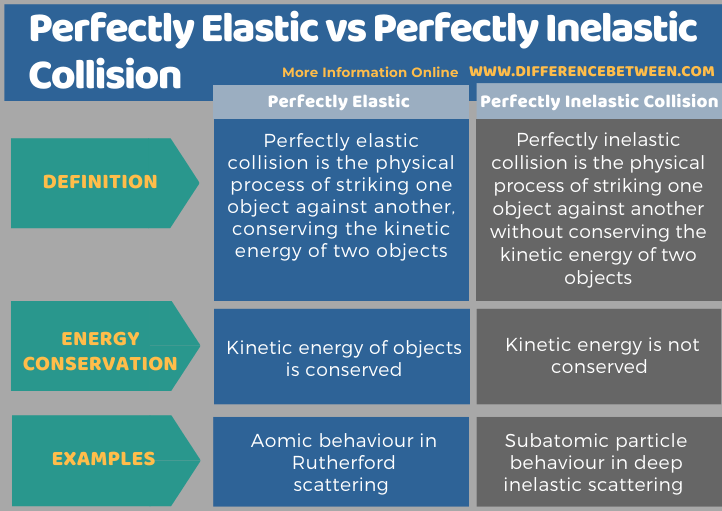The key difference between perfectly elastic and perfectly inelastic collision is that in perfectly elastic collisions, the total kinetic energy of the objects remains the same, whereas, in perfectly inelastic collisions, the total kinetic energy of the objects does not remain the same.
A perfectly elastic collision is the opposite of a perfectly inelastic collision. Collision is the physical process of two objects striking against each other.
CONTENTS
1. Overview and Key Difference
2. What is a Perfectly Elastic Collision
3. What is a Perfectly Inelastic Collision
4. Side by Side Comparison – Perfectly Elastic vs Perfectly Inelastic Collision in Tabular Form
5. Summary
What is a Perfectly Elastic Collision?
A perfectly elastic collision is the physical process of striking one object against another, conserving the kinetic energy of two objects. A perfectly elastic collision is an ideal elastic collision where there is no net conversion of kinetic energy into other energy forms such as heat, noise, or potential energy. But in real life, there are no perfectly elastic collisions because kinetic energy always tends to convert into other energy forms.

Generally, during the collision of small bodies, kinetic energy tends to convert into potential energy first (which is associated with a repulsive force between the two bodies). This happens when particles move against the repulsive force. Then the potential energy tends to convert back to kinetic energy. This happens when particles move with repulsive force. In a perfectly elastic collision, the energy conversions show no net energy loss.
As a real-life example, collisions of atoms is a nearly perfectly elastic collision. For example, Rutherford backscattering is an application of elastic collision of atoms. Furthermore, molecules in gases or liquids rarely show perfectly elastic collisions. In addition to these, we can approximate perfectly elastic collisions by the interactions of objects such as billiard balls.
What is a Perfectly Inelastic Collision?
A perfectly inelastic collision is the physical process of striking one object against another without conserving the kinetic energy of two objects. This is the opposite of a perfectly elastic collision. The kinetic energy is not conserved in a perfectly inelastic collision because of the internal friction.

However, inelastic collisions tend to obey conservation of momentum although these collisions do not conserve kinetic energy. In the field of nuclear physics, we can identify inelastic collisions in incoming particles that cause the nucleus to become excited or to break up. Here, deep inelastic scattering is a technique in which probing the structure of subatomic particles shows perfectly inelastic collisions.
What is the Difference Between Perfectly Elastic and Perfectly Inelastic Collision?
Elastic and inelastic collision are physical processes that involve the striking of an object against another object. The key difference between perfectly elastic and perfectly inelastic collision is that in a perfectly elastic collision, the total kinetic energy of the objects remains the same, whereas, in a perfectly inelastic collision, the total kinetic energy of the objects does not remain the same.
Below is a summary of the difference between perfectly elastic and perfectly inelastic collision in tabular form.

Summary – Perfectly Elastic vs Perfectly Inelastic Collision
A perfectly elastic collision is the opposite of a perfectly inelastic collision. The key difference between perfectly elastic and perfectly inelastic collision is that in a perfectly elastic collision, the total kinetic energy of the objects remains the same, whereas, in perfectly inelastic collisions, the total kinetic energy of the objects does not remain the same.
Reference:
1. “What Is Inelastic Collision? – Definition, Formula, Examples.” BYJUS, 21 Jan. 2021, Available here.
Image Courtesy:
1. “Translational motion” By A. Greg (Greg L at English Wikipedia) – Own work (Public Domain) via Commons Wikimedia
2. “Bouncing ball strobe edit” By MichaelMaggs Edit by Richard Bartz – Own work (CC BY-SA 3.0) via Commons Wikimedia
ncG1vNJzZmivp6x7pbXFn5yrnZ6YsqOx07CcnqZemLyue8OinZ%2Bdopq7pLGMm5ytr5Wau268xKudnpukocZuscuaqq2hk2Kur7CMqZyrnpWYwa3FjKKlnqSRqMGqr4ycpqWkmai2sLqO